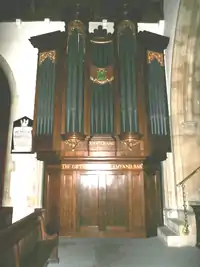George Amyand
Sir George Amyand, 1st Baronet (26 September 1720 – 16 August 1766)[1] was a British Whig politician, physician and merchant.


Origins
He was the second son of Claudius Amyand, Surgeon-in-Ordinary to King George II,[2] by his wife Mary Rabache, and was baptised at the fashionable St James's Church, Piccadilly.[1] Claudius's father was a Huguenot who had quitted France following the Revocation of the Edict of Nantes in 1685.[2]
Career
Amyand was Army Contractor during the Seven Years' War,[3] an assistant to the Russia Company in March 1756 and a director of the East India Company in 1760 and 1763.[4] In that year, he bought the manor of Frilsham, Berkshire from Willoughby Bertie, 4th Earl of Abingdon.[5]
Between 1754 and 1766, Amyand sat as Member of Parliament (MP) for Barnstaple,[6] in North Devon. On 9 August 1764, he was created a baronet, of Moccas Court, in the County of Hereford.[7]
Marriage and progeny
In 1748 he married Anna Maria Korteen (d. 1767), daughter of John Abraham Korteen (alias Kerton[2]), a German merchant of Hamburg,[4] by whom he had two sons and two daughters:[2]
- Sir George Cornewall, 2nd Baronet (1748–1819), eldest son and heir, who changed his surname and arms to Cornewall following his marriage to the heiress of that family.
- John Amyand (1751–1780 ), MP for Camelford.
- Anna-Maria Amyand (1752–1829), married Gilbert Elliot, 1st Earl of Minto (after whom the Lady Elliot was probably named).[8]
- Harriet Maria Amyand (1761–1830), married James Harris, 1st Earl of Malmesbury
Death and burial
Amyand died on 16 August 1766, aged 45, from unknown causes, and was buried at Carshalton a week later.[1]
Monument
In the outer south aisle of All Saints Church, Carshalton is a white marble urn, with an inscription in his memory.[9][10]
Barnstaple organ donation
He donated the present organ in St Peter's Church, Barnstaple, one of the largest in Devon, made by John Crang in 1764.[11] It is decorated with his armorials: Vert, a chevron between three garbs or[2] with an inescutcheon of unidentified arms.
References
- Cokayne, George Edward, ed. (1900). Complete Baronetage. Exeter: William Pollard. p. 130.
- Courthope, William, ed. (1835). Debrett's Baronetage of England (7th ed.). London: J.G. & F. Rivington. p. 185.
- "History". Moccas Court. Archived from the original on 16 July 2014. Retrieved 16 June 2015.
- Kimber, Edward (1771). Richard Johnson (ed.). The Baronetage of England: Containing a Genealogical and Historical Account of All the English Baronets. vol. III. London: Thomas Wotton. p. 203.
- Page, William; Ditchfield, P H, eds. (1924). "Parishes: Frilsham". A History of the County of Berkshire. Volume 4. London: Victoria County History. pp. 70–73. Retrieved 31 January 2016.
- Namier, Lewis (1964). "Amyand, George (1720–66)". In Namier, Sir Lewis; Brooke, John (eds.). The House of Commons 1754-1790. The History of Parliament Trust.
- "No. 10442". The London Gazette. 7 August 1764. p. 1.
- Yarrow, Stephen. "Naming Australia's Coastline". Pocket Oz Guide to Australia. Retrieved 5 December 2020.
- Lysons, Daniel (1792). The Environs of London: Volume 1: County of Surrey. London: T Cadell and W Davies. pp. 122–136.
- "Interior". All Saints Carshalton. Retrieved 16 June 2015.
- Per gilded inscription on organ
| Parliament of Great Britain | ||
|---|---|---|
| Preceded by Thomas Benson Sir Bourchier Wrey |
Member of Parliament for Barnstaple 1754–1766 With: John Harris 1754–1761 Denys Rolle 1761–1766 |
Succeeded by Denys Rolle John Clevland |
| Baronetage of Great Britain | ||
| New creation | Baronet (of Moccas Court) 1764–1766 |
Succeeded by George Cornewall |